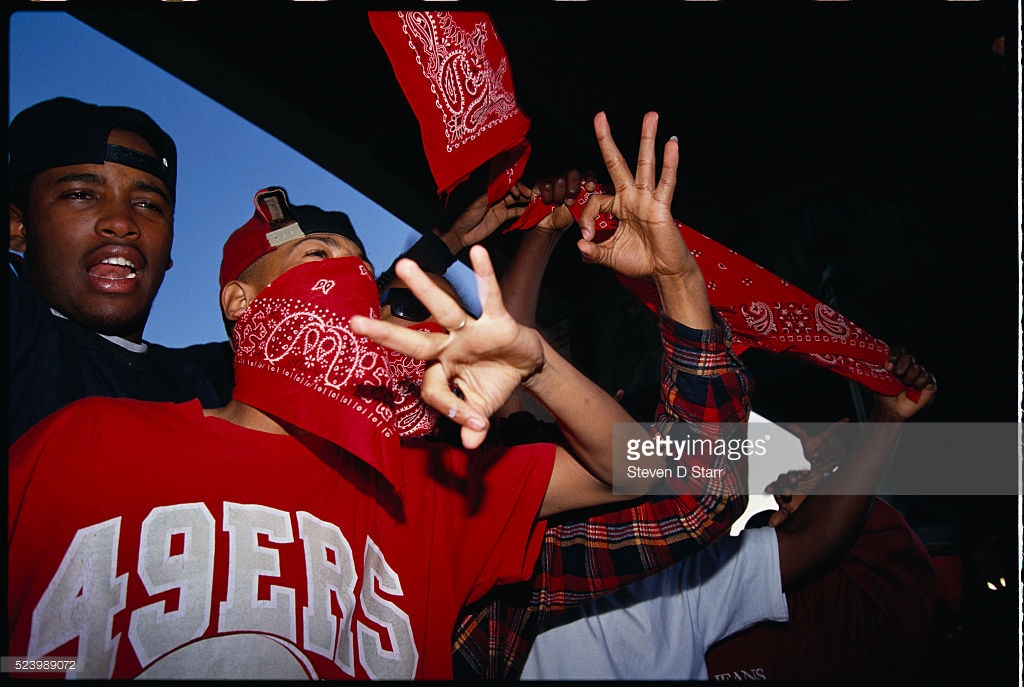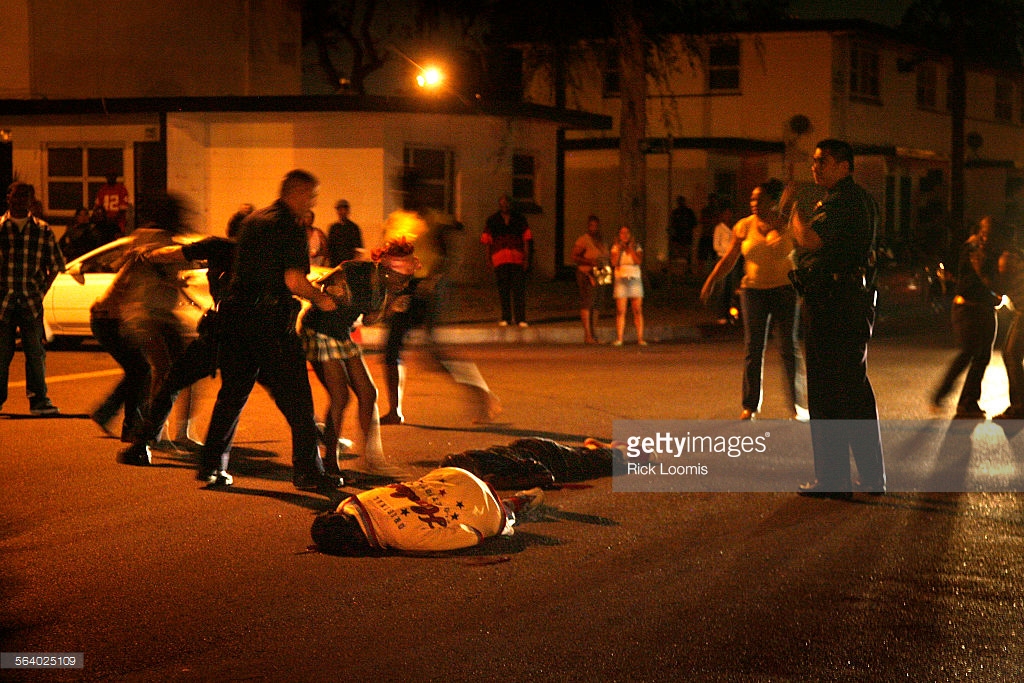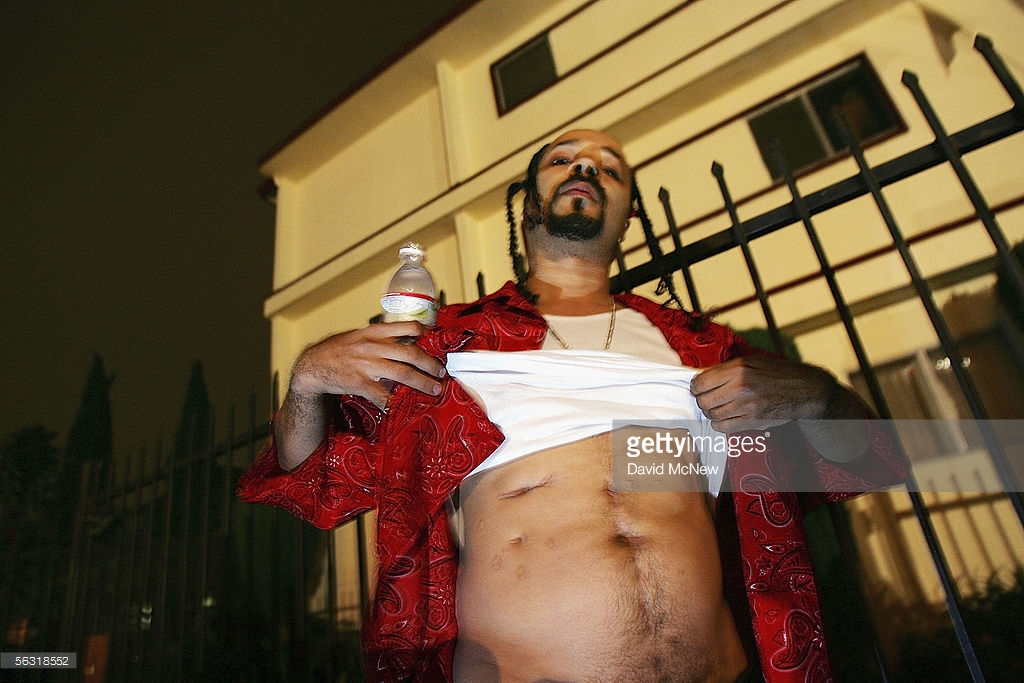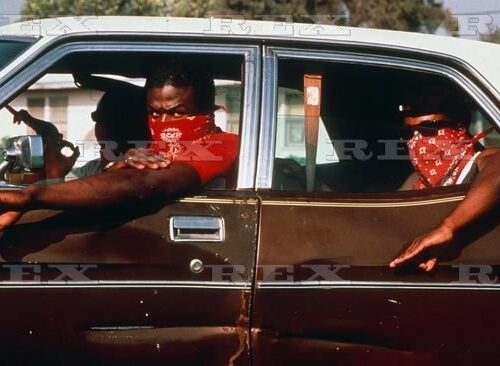
Flying the red flag of the Blood Army has never been easy. Outnumbered by the Crips in LA, they’ve expanded across the nation to become a Super Gang.
Gang banging on the streets of Los Angeles is a lifestyle. A vicious cycle that repeats itself generation after generation. Young black and brown soldiers represent their hoods in the streets, dying in the field of battle. If it’s not rough, its not right and there’re only two outcomes for a gangbanger- death or jail- and on the mean streets of LA, in the realm of a Blood gang member, the inner-city can resemble a war zone.

LA Gangbanger Ground Zero
In California gangs are a way of life and LA is considered gangbanger central. The Crips, Sureno’s, Norteno’s, Nazi Low Riders and Bloods all hold court in the streets, battling for gangland supremacy. According to Blood legend the red in their bandanna symbolizes the blood they’ve shed, the white in the red symbolizes the celestial bodies, stars or heaven and the black in the red symbolizes the bangers as black people. A gang’s effect on a neighborhood can vary widely, but residents generally say their impact is overwhelmingly negative.
Legend has it that the Bloods started in the summer of 1972 when a member of the LA Brims, a westside independent gang was shot and killed by a Crip member after a confrontation. Being heavily outnumbered by the Compton Crips and thus no match for them in a gang fight the LA Brims turned to the Piru Street Boys, Lueders Park Hustlers and Denver Lanes, three other non-crip gangs, for assistance. Before the ensuing rumble a meeting was called on Piru Street in Compton where the 4 non-crip gangs met and metamorphosed into the Bloods. To distinguish themselves from the Crips and their traditional blue bandanas the newly form Bloods decided to fly red rags and so the war of colors was launched.
“Neighborhoods all across the City of Angels in the 1980s were expanding, growing and swallowing up more territory in a desperate land grab to determine which neighborhoods would control and monopolize the city through terror.” says Terrell “Loko” Wright, an OG Neighborhood Blood serving life in the California Department of Corrections who wrote Home of the Body Bags, a memoir on gang banging. “In the early days we beefed simply because we were Bloods and they were Crips. That was the unique dynamic all across the city. Simply because we were from opposite ends of the spectrum.”
In the housing projects of South Central, Watts and Compton young black males lined up to join the gangs. They wanted the reputation, prestige and protection that came along with being a member of the Blood or Crip army. As their antics and exploits grew the idea of the gangs spread to projects all over the city. Inspiring a generation of youth to start their own sets all over the United States and beyond.
Crack Money and Drug Dealers
When crack hit the scene in the 1980s the Blood/Crip rivalry became even more fierce. With millions of dollars of cocaine money to be had the gangs transformed into multi-faceted criminal organizations that ran retail drug spots, traveled out-of-town to sell drugs and protected their territories with a vengeance. The gangs spread outward from LA and established roots all over the nation. All it took was one LA gang member in a city and he could turn whole neighborhoods to the red flag.
“I’m a second generation Damu (Blood) and I was affiliated heavily with those wicked streets of Inglewood growing up as a teenager.” Clifford “Spud” Johnson, a Blood OG who stated opening urban fiction novels in prison, tells Real Crime. “I got caught up in the gang lifestyle and drug dealing (crack) in the early 80s. That in turn made me very aggressive towards getting money. Hungry for real. I ended up in Oklahoma City in 1992 selling drugs and made that city my home after meeting the mother of my children.
“I was arrested by the FBI in 1999 and received a 210 month sentence for distribution of 13.5 kilos of crack. I’m from 111 Street Center Park Bloods, we were originally a branch of the Inglewood Family Gangsters (IFG) until our O/G homies decided we should stand on our own and make the name CPB mean something without the help of our originators. Inglewood has always been dominated by Damus. My set, CPB is one of the smaller sets in Inglewood, yet still one of the most dangerous. I love my hood and I will forever be linked to the set, but my life is headed in a different direction now.”
The gangs resemble paramilitary organizations in terms of their hierarchical structures. While some sets are less rigid than others when it comes to chain of command, younger members generally take orders from mid-level soldiers, who answer directly to the gang’s highest-ranking members/leaders. This kind of command structure tends to inoculate set leaders from legal exposure at the street level, ensuring that younger members carry out shootings, assaults, on-the-ground drug deals, and other gang-related actions at their behest. Of course, the leaders were once low-ranking gangsters themselves, putting in work at the behest of their superiors. The younger members of today’s gangs tend to view their set leaders with respect, even awe, and aspire to exert the same kind of power over their fellow gangsters one day.
“They generally control outdoor drug markets and associated locations- stash houses, shooting galleries, crack dens- in communities with high heroin and cocaine addiction rates.” Says Kevin Deutsch, author of The Triangle: A year on the Ground with New York’s Bloods and Crips. “They use runners and lookouts on designated corners or near specific buildings where they keep larger stashes of drugs. They run their operations like a legitimate business, giving discounts to their best customers, using promotions like two-for-one vials or baggies to increase daily sales and attract new customers, and utilizing word-of-mouth advertising about their products’ potency. They use force—and the threat of force—to keep rival gangs and start-up crews out of their territory.”

Expansion Across the United States
Gangs in the City of Angels are nothing if not recklessly rampant, and gang activity doesn’t just happen in the big city. The blueprints for banging have infested smaller towns and spread across the nation. The ideology has transgressed ethnic, racial and geographical boundaries. Gang banging exists not only in the hood, but even in the suburbs and rural areas all over the country. The gang become very popular in the New York State prison system and spread like a cancer to the streets.
“The biggest gangs in New York are obviously influenced by the Department of Corrections (DOC) and filter to the streets.” Ron “Cook” Barrett, an upstate New York gang expert, tells Real Crime. “Traditionally, since 1993, the Bloods have been the power within Riker’s Island and many state correctional facilities. Sets like the Mac Ballers, G Shine, Brims, and Gorilla Brims have been active and constantly fight for control of facilities. They outnumber many rivals.”A big change for the original Blood sets of LA, who were under constant pressure from their lifelong enemies, the Crips, who outnumbered them 3-1.
“The Blood Army is always outnumbered in any given situation. Since we have the odds always stacked against us the Bloods have to have twice the courage in the field of battle, which is everywhere, or we would cease to exist as an entity.” OG Loko says. ”It gave us the opportunity to be a part of something grandeur, majestic, mystical and dominating in the hearts and minds of those who stood on the side line, admiring and awing over the gang-bangers life.”
During his incarceration at Riker’s Island in 1996, Peter “Pistol Pete” Rollock, a Bronx drug lord joined the Bloods. East Coast Blood founders, Omar “OG Mack” Portee and Leonard “Deadeye” Mackenzie, recruited Pistol Pete into the United Blood Nation (UBN). Pistol Pete’s set- Sex, Money, Murder- were the scourge of the Sound View section of the Bronx back in the day. Pistol Pete was known as a gunslinger and was one of the most feared and powerful men in New York during the crack era. People were killed on his word alone. (see box out Infamous Blood Legends)
“The wars are fewer than it once was, but when they do commence they’re bloody and violent.” Loko tells Real Crime. “Unlike back in the days when the wars were more rampant as many L.A. gangs vied to be the biggest fish in the ocean. We did what damage we could with our simple revolvers. But in today’s time when wars jump-off the automatics are brought out and most times multiple body counts of dead are the results. Most wars today are brief, but very, very traumatic. But don’t get me wrong, it’s always a state of warfare between the tribes.”
Pop Culture and Gangs
As the Blood-Crip conflict moves into its 45th year the gangs have become a trend in popular culture and society as a whole to a large degree. Banging has consumed pop culture, first with movies like Colors and Menace II Society and secondly with Snoop Dog and The Game flashing gang signs in music videos. Tons of rapper claim Blood and the LA gang banger style has been appropriated by Hollywood just like the Mafia was before them.
“It’s funny to me for real because now it seems so popular to be a Damu.” Spud tells Real Crime. “You got rappers like the homies Mack 10, The Game, Lil Weezy, Baby, Jim Jones, Tech9 and Mitchy Slick doing their thing. But these men need to realize what they’re promoting. They’re promoting death and violence to our youth for real. Being a Blood or Crip ain’t cool. Some kid that doesn’t know any better will take certain words said by their favorite rapper and go out and do some goofy shit thinking that’s the business and that’s tragic.”
When Death Row Records was at its height, Suge Knight was a walking billboard for the gang. He made no bones about his alliances and even used his gang banging cohorts to muscle industry people and journalists. A member of the Mob Piru Bloods, Suge Knight epitomized what it was like to be a Blood living the high life in hip-hop. An image many other entertainers and gang bangers have tried to emulate.
Today
Throughout the 70’s, 80’s and into the 90’s the Blood/Crips rivalry grew as did the numbers associated with the gang and their presence in cities and areas across the nation. The warfare has raged on unabated. Bloods wanted to be known as Crip Killers, but recently the state of the war has changed as more and more Crips and Bloods have been fighting a more common enemy. The fight in LA has turned from Blood versus Crip and black versus black to Blood and Crip versus Sureno’s (Mexicans/Chicanos) and black versus brown.
“Today is no different than the old: gang wars, funerals, lives destroyed and many more adversities to overcome.” Loko tells Real Crime. “The only difference today, is instead of the traditional Blood-vs-Crip wars, and Mexican (cholos)-vs- Mexican warfare, the two predominate groups in Southern California, have now turned their guns on each other. It’s the new trend of black gangsters-vs-brown gangsters. But it’s a no win situation, as the only for sure outcome, is that there will be more chaos and destruction left behind then it was the day before.”
All across LA, and its many highways and byways, the black and brown gangsters are drawing up new battle lines, re-drawing and re-establishing new demilitarized zones, inside communities they once happily shared together, and are killing each other at an alarming rate. It’s gotten so bad that Snoop Dog (a Crip) and The Game (a Blood) even had a peace rally to stop the killing.
“The blood baths have left the two groups taking it to dimensions of warfare that’s considered something new to many of the LA gangsters: racial targeting and culture clashes.” Loko says. “It’s the new trend and sadly enough it’ll be here for a while and as it buries itself deeper into the fine woven material of the LA stage of drama, more lives will be lost, and many more heart breaks for family, friends, homies, brothers, cousins, fathers, and uncles. The loss of lives will continue to rise out of control.”




1 Comment
Bunch of wayward kids who were raised with no father figure or mentors. They ALL will end up dead, in jail, or doing life. Find a damn skill!